Why does that hamburger on TV not look like the one you just bought?
National Public Radio tells the story of how “food stylists” do their magic to make food look appetizing in video and photography. It’s an art, complete with plenty of books on the subject.
Below the story, several people at the NPR site suggested that the practice of styling food for photo (such as using acrylic or glue instead of milk) is unethical.
One reader wrote:
Why is food exempt from deceptive advertising? If your life depended on it, you couldn’t purchase a sandwich that has the quantity of ingredients shown in an ad.
Others defend the practice, noting that “[e]ven supermodels need makeup for a photoshoot.”
What do you think?
* Is it unethical to show pictures of food that aren’t food, or does the inherent problems in photographing food make it OK?
* Should there be different standards in photography for journalists and advertisers?
* Should companies that use such practices be required to reveal that fact to the public? Does the phrase “serving suggestion” you see in some ads/labels suffice?
* How would the “W’s and H” checklist inform you as you think about the topic? What specific questions on that list would be the most thorny?
